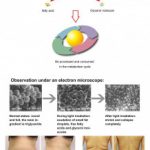Infrared heating pads have become increasingly popular in recent years as a natural and non-invasive method of pain relief. However, questions still remain regarding their effectiveness in providing relief from various types of pain. In this discussion, we will explore the topic in depth, examining the scientific evidence and anecdotal experiences to answer the question: do infrared heating pads really work?
Contents
Understanding Infrared Technology
Infrared heating pads use infrared light to penetrate the skin and tissue, providing therapeutic heat to the affected area. This technology has been used for decades in various medical and therapeutic applications, including physical therapy, sports medicine, and pain management. Unlike traditional heating pads, which only provide surface-level heat, infrared heating pads deliver heat deep into the muscles and joints, promoting circulation and relaxation.
How Infrared Heat Works
Infrared heat is a type of electromagnetic radiation that is invisible to the human eye. It is the same type of heat that we feel from the sun, but without the harmful ultraviolet rays. When infrared light penetrates the skin, it creates vibration in the tissues, which generates heat. This heat then spreads throughout the body, promoting circulation and relaxation.
Benefits of Infrared Heating Pads
Infrared heating pads offer several benefits over traditional heating pads. The deep penetrating heat helps to increase blood flow to the affected area, promoting healing and reducing pain. This type of heat therapy also helps to relax muscles and reduce inflammation, making it an effective treatment for conditions such as arthritis, fibromyalgia, and back pain.
Clinical Studies
Numerous clinical studies have been conducted on the effectiveness of infrared heating pads. One study published in the Journal of Complementary and Alternative Medicine found that infrared heat therapy was effective in reducing pain and stiffness in patients with knee osteoarthritis. Another study published in the Journal of Physical Therapy Science found that infrared heat was effective in reducing muscle fatigue and promoting muscle recovery in athletes.
How to Use Infrared Heating Pads
To use an infrared heating pad, simply apply it to the affected area and turn it on. Most infrared heating pads have adjustable temperature settings, so you can customize the heat level to your comfort level. It is important to follow the manufacturer’s instructions and not to use the heating pad for longer than recommended to avoid burns or other injuries.
Misconceptions About Infrared Heating Pads
Despite the numerous clinical studies and anecdotal evidence supporting the effectiveness of infrared heating pads, there are still some misconceptions about this technology. One common misconception is that infrared heating pads are only effective for surface-level pain, such as sore muscles. However, as we discussed earlier, infrared heat penetrates deep into the muscles and joints, making it an effective treatment for a wide range of conditions.
Another misconception is that infrared heating pads are unsafe or can cause burns. While it is true that any type of heat therapy carries some risk of burns or injuries, as long as you use the heating pad according to the manufacturer’s instructions and do not use it for longer than recommended, the risk of injury is minimal.
A key takeaway from this text is that infrared heating pads use infrared light to penetrate the skin and tissue, delivering deep penetrating heat that promotes circulation and relaxation. They are effective in reducing pain and stiffness in conditions such as arthritis, fibromyalgia, and back pain. While generally safe, it is important to follow the manufacturer’s instructions and consult with a healthcare provider before using if you have a pacemaker or other medical device. Infrared heating pads should not be used as a substitute for medical treatment or medication for chronic pain.







